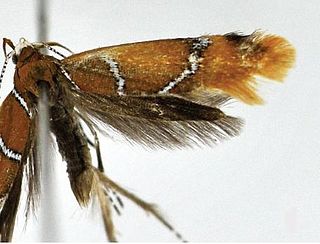
Oecophoridae is a family of small moths in the superfamily Gelechioidea. The phylogeny and systematics of gelechoid moths are still not fully resolved, and the circumscription of the Oecophoridae is strongly affected by this.

The Elachistidae are a family of small moths in the superfamily Gelechioidea. Some authors lump about 3,300 species in eight subfamilies here, but this arrangement almost certainly results in a massively paraphyletic and completely unnatural assemblage, united merely by symplesiomorphies retained from the first gelechioid moths.

The Gelechiidae are a family of moths commonly referred to as twirler moths or gelechiid moths. They are the namesake family of the huge and little-studied superfamily Gelechioidea, and the family's taxonomy has been subject to considerable dispute. These are generally very small moths with narrow, fringed wings. The larvae of most species feed internally on various parts of their host plants, sometimes causing galls. Douglas-fir (Pseudotsuga) is a host plant common to many species of the family, particularly of the genus Chionodes, which as a result is more diverse in North America than usual for Gelechioidea.

Casuarina, also known as she-oak, Australian pine and native pine, is a genus of flowering plants in the family Casuarinaceae, and is native to Australia, the Indian subcontinent, Southeast Asia, islands of the western Pacific Ocean, and eastern Africa.

Gelechioidea is the superfamily of moths that contains the case-bearers, twirler moths, and relatives, also simply called curved-horn moths or gelechioid moths. It is a large and poorly understood '"micromoth" superfamily, constituting one of the basal lineages of the Ditrysia.
Crossophora is a genus of gelechioid moths from eastern Australia. It belongs to the family Oecophoridae, and therein to subfamily Oecophorinae. The genus was described by Edward Meyrick in 1883. As regards described species, it is monotypic. But at least one undescribed species is known to exist:

The Ethmiinae are a subfamily of small moths in the superfamily Gelechioidea sometimes included in the Elachistidae or the Oecophoridae, but mostly in the Depressariidae as a subfamily Ethmiinae.

Psaroxantha calligenes is a moth of the family Oecophoridae. It is found in Australia, including Tasmania.

Scythris is a genus of gelechioid moths. It is the type genus of the flower moth family, which is sometimes included as a subfamily in the Xyloryctidae, or together with these merged into the Oecophoridae. The genus was erected by Jacob Hübner in 1825.

The Autostichinae are a subfamily of moths in the superfamily Gelechioidea. Like their relatives therein, their exact relationships are not yet very well resolved. The present lineage was often included in the concealer moth family (Oecophoridae), but alternatively it is united with the Symmocidae sensu stricto to form an expanded family Autostichidae.

Autosticha is a genus of gelechioid moths. It belongs to the subfamily Autostichinae, which is either placed in the concealer moth family (Oecophoridae), or in an expanded Autostichidae. It is the type genus of its subfamily. Originally, this genus was named Automola, but this name properly refers to a fly genus in family Richardiidae.

Xyloryctidae is a family of moths contained within the superfamily Gelechioidea described by Edward Meyrick in 1890. Most genera are found in the Indo-Australian region. While many of these moths are tiny, some members of the family grow to a wingspan of up to 66 mm, making them giants among the micromoths.

Promalactis is a genus of moths of the family Oecophoridae.

Psorosticha is a moth genus of the superfamily Gelechioidea. It is included in the family Depressariidae, which is sometimes – particularly in older treatments – considered a subfamily of the Oecophoridae or included in the Elachistidae.
Eclactistis is a genus of moths of the family Oecophoridae.
Hozbeka is a monotypic moth genus in the family Oecophoridae erected by Hüseyin Özdikmen in 2009. Its only species, Hozbeka anomala, was described by John Frederick Gates Clarke in 1978. It is found in Chile.
Cryptolechia is the scientific name of two genera of organisms and may refer to:
Despina rhodosema is a moth in the family Oecophoridae first described by Edward Meyrick in 1931. It is the only species in the monotypic genus Despina erected by John Frederick Gates Clarke in 1978. It is found in Chile.
Atha is a monotypic moth genus in the family Oecophoridae. Its only species, Atha trimacula, is found in Chile. Both the genus and species were described by John Frederick Gates Clarke in 1978.
Teresita is a genus of moths in the family Oecophoridae described by John Frederick Gates Clarke in 1978.










